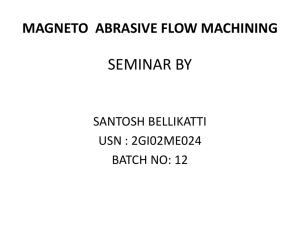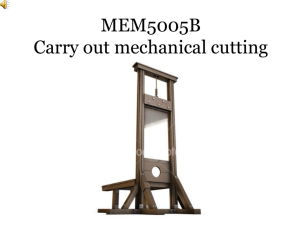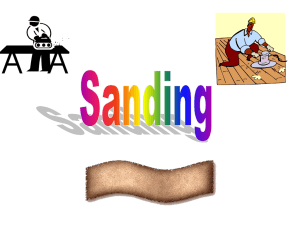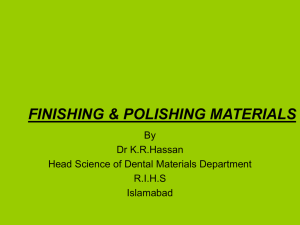PD_NVQ2_A_Ch10_10.3
advertisement
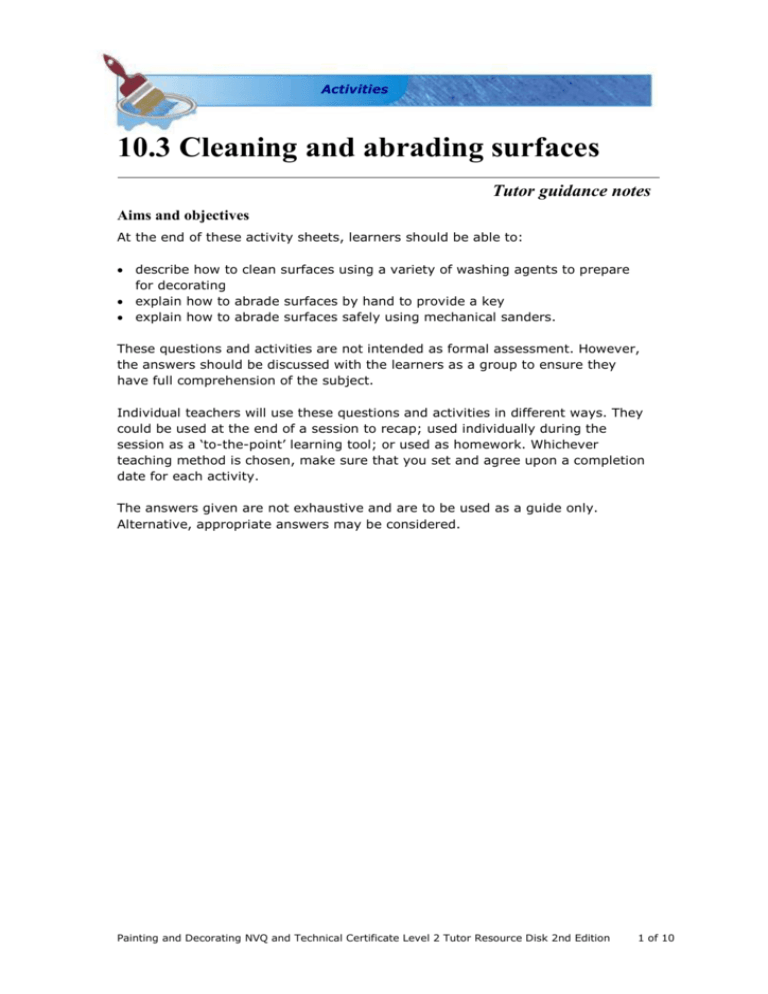
Activities 10.3 Cleaning and abrading surfaces Tutor guidance notes Aims and objectives At the end of these activity sheets, learners should be able to: describe how to clean surfaces using a variety of washing agents to prepare for decorating explain how to abrade surfaces by hand to provide a key explain how to abrade surfaces safely using mechanical sanders. These questions and activities are not intended as formal assessment. However, the answers should be discussed with the learners as a group to ensure they have full comprehension of the subject. Individual teachers will use these questions and activities in different ways. They could be used at the end of a session to recap; used individually during the session as a ‘to-the-point’ learning tool; or used as homework. Whichever teaching method is chosen, make sure that you set and agree upon a completion date for each activity. The answers given are not exhaustive and are to be used as a guide only. Alternative, appropriate answers may be considered. Painting and Decorating NVQ and Technical Certificate Level 2 Tutor Resource Disk 2nd Edition 1 of 10 Activities Candidate name: Date: 10.3 Cleaning and abrading surfaces Chapter 10: Preparation of surfaces Aims and objectives At the end of these activity sheets, you should be able to: describe how to clean surfaces using a variety of washing agents to prepare for decorating explain how to abrade surfaces by hand to provide a key explain how to abrade surfaces safely using mechanical sanders. 1 Describe how to treat a generally sound surface with small areas of flaking paint, prior to cleaning. ___________________________________________________________ ___________________________________________________________ ___________________________________________________________ 2 If a surface looks clean, do you still need to clean it before painting? ___________________________________________________________ ___________________________________________________________ ___________________________________________________________ Why is it particularly important to remove tar residue from tobacco smoke? ___________________________________________________________ ___________________________________________________________ 3 Name two washing agents that can be used to remove everyday dirt and grime from paintwork. ___________________________________________________________ ___________________________________________________________ Why should you start at the bottom and work upwards when washing a surface? ___________________________________________________________ Painting and Decorating NVQ and Technical Certificate Level 2 Tutor Resource Disk 2nd Edition 2 of 10 Activities 4 Name two substances that can be used to remove oily and greasy marks. ___________________________________________________________ ___________________________________________________________ How should these substances be applied? ___________________________________________________________ When you have finished removing marks with either of these substances, what must you do? ____________________________________________________________ 5 Why is abrading such an important part of surface preparation? ___________________________________________________________ ___________________________________________________________ ___________________________________________________________ 6 What problems can result from using the following abrasives? An abrasive that is too rough: ________________________________ _________________________________________________________ An abrasive that is too fine: __________________________________ _________________________________________________________ _________________________________________________________ Cheap, inadequate abrasives: ________________________________ _________________________________________________________ 7 Why is wet and dry abrasive paper more suited to wet use? ___________________________________________________________ Painting and Decorating NVQ and Technical Certificate Level 2 Tutor Resource Disk 2nd Edition 3 of 10 Activities 8 This text gives some more information about wet and dry abrasive paper. Complete the text by writing the missing words. The aggregates (abrasive particles) used in wet and dry abrasive paper have traditionally been ___________ carbide, but _____________ oxide is now becoming increasingly popular. The particles of aggregate are closely grouped together and are referred to as being ‘_________ _________’. Water, or sometimes ___________ oil, can be used as a lubricant, which prevents the paper from becoming ____________. Wet and dry abrasive paper is available in grades from P80 (_________) through to P1200 (very ______). 9 State the advantages and disadvantages of using wet and dry abrasive paper. advantages: ______________________________________________ _________________________________________________________ _________________________________________________________ disadvantages: ____________________________________________ _________________________________________________________ _________________________________________________________ 10 Name three types of dry abrasive. ___________________________________________________________ ___________________________________________________________ ___________________________________________________________ 11 This text gives some more information about dry abrasives. Complete the text by writing the missing words. Aluminium oxide abrasive, sometimes referred to as ________________ paper, is usually available ‘______ coated’, where the particles of _____________ are spaced apart on the backing paper. This reduces the risk of ____________ as the gaps between the aggregate particles allow waste to escape. A dry _________ lubricant can be used on some types of dry abrasives, which breaks away when ______ is generated by the abrading process, preventing clogging of the abrasive. Painting and Decorating NVQ and Technical Certificate Level 2 Tutor Resource Disk 2nd Edition 4 of 10 Activities 12 These are lists of the advantages and disadvantages of using dry abrasives. One advantage and one disadvantage do not belong on the lists. Cross out the two incorrect statements. advantages: Aluminium oxide papers are available in grades ranging from coarse through to very fine. When aluminium oxide wears down, particle edges shear off, revealing another smaller but sharper edge. It cleans the surface as it abrades. It is available in sheet, roll, disc and belt form. It is also available in self-adhesive rolls so that the abrasive can be torn off and then fixed to a purpose-made rubbing block. disadvantages: Aluminium oxide paper can be expensive (but when compared with other abrasives it is more economical in the long-term). It creates high dust levels. It becomes clogged very quickly. 13 On the following grades of abrading paper, how many particles of aggregate are there in a 25 25 mm area? P20: ______________________ P80: ______________________ P1200: ______________________ 14 Three words are incorrect in this text about powered sanders. Cross out the incorrect words, and write the correct words above them. Belt and orbital sanders are hand-held power tools best used for sanding small, flat items of joinery. A drum sander is self-propelled and used for stripping walls. A rough grade of abrading material should be used first to remove the surface coating. The rough surface can then be brought up to a smooth finish by progressively using finer and finer abrading material. Painting and Decorating NVQ and Technical Certificate Level 2 Tutor Resource Disk 2nd Edition 5 of 10 Activities 15 State the advantages and disadvantages of using belt, orbital and drum sanders. advantages: ______________________________________________ _________________________________________________________ disadvantages: ____________________________________________ _________________________________________________________ _________________________________________________________ 16 List three types of abrasive disc for use with disc or rotary sanders. ___________________________________________________________ ___________________________________________________________ ___________________________________________________________ 17 State the advantages and disadvantages of using disc or rotary sanders. advantages: ______________________________________________ _________________________________________________________ _________________________________________________________ disadvantages: ____________________________________________ _________________________________________________________ 18 Describe how to deal with dust created when using an electrical sander. ___________________________________________________________ ___________________________________________________________ ___________________________________________________________ ___________________________________________________________ Painting and Decorating NVQ and Technical Certificate Level 2 Tutor Resource Disk 2nd Edition 6 of 10 Activities 10.3 Cleaning and abrading surfaces Chapter 10: Preparation of surfaces Answers 1 Describe how to treat a generally sound surface with small areas of flaking paint, prior to cleaning. Remove the flaking paint to form a solid edge. Spot prime the bare areas. When the primer has dried, surface-fill the edges of the repaired area with a suitable filling agent. 2 If a surface looks clean, do you still need to clean it before painting? yes, because substances such as dirt, grease and everyday grime can contaminate a surface without it looking like the area is dirty Why is it particularly important to remove tar residue from tobacco smoke? Tar affects the adhesion of paint to a surface, and can bleed through emulsion paint. 3 Name two washing agents that can be used to remove everyday dirt and grime from paintwork. sugar soap mild detergent Why should you start at the bottom and work upwards when washing a surface? This avoids streaking of painted surfaces. 4 Name two substances that can be used to remove oily and greasy marks. white spirit turpentine How should these substances be applied? with a cloth or brush When you have finished removing marks with either of these substances, what must you do? Rinse the area thoroughly and allow it to dry completely. Painting and Decorating NVQ and Technical Certificate Level 2 Tutor Resource Disk 2nd Edition 7 of 10 Activities 5 Why is abrading such an important part of surface preparation? It provides a key for the coating or covering to be applied, and smoothes the surface in order to give a good quality finish. 6 What problems can result from using the following abrasives? An abrasive that is too rough: can leave scratches on surfaces that show through to the finish. An abrasive that is too fine: can result in preparation taking longer than necessary, and may be ineffective at removing or levelling rough surface imperfections. Cheap, inadequate abrasives: can greatly extend the preparation time because they tend to get blunt and clog very quickly. 7 Why is wet and dry abrasive paper more suited to wet use? It tends to clog up when used dry. 8 This text gives some more information about wet and dry abrasive paper. Complete the text by writing the missing words. The aggregates (abrasive particles) used in wet and dry abrasive paper have traditionally been silicon carbide, but aluminium oxide is now becoming increasingly popular. The particles of aggregate are closely grouped together and are referred to as being ‘closed coated’. Water, or sometimes mineral oil, can be used as a lubricant, which prevents the paper from becoming clogged. Wet and dry abrasive paper is available in grades from P80 (coarse) through to P1200 (very fine). 9 State the advantages and disadvantages of using wet and dry abrasive paper. advantages: extremely good for high-quality work; wide range of grades available; cleans the surface as it abrades; low dust levels disadvantages: more expensive than dry abrasives; unsuitable for bare timber; clogs up easily if used dry; the surface has to dry before it can be decorated 10 Name three types of dry abrasive. glass garnet aluminium oxide Painting and Decorating NVQ and Technical Certificate Level 2 Tutor Resource Disk 2nd Edition 8 of 10 Activities 11 This text gives some more information about dry abrasives. Complete the text by writing the missing words. Aluminium oxide abrasive, sometimes referred to as production paper, is usually available ‘open coated’, where the particles of aggregate are spaced apart on the backing paper. This reduces the risk of clogging as the gaps between the aggregate particles allow waste to escape. A dry powder lubricant can be used on some types of dry abrasives, which breaks away when heat is generated by the abrading process, preventing clogging of the abrasive. 12 These are lists of the advantages and disadvantages of using dry abrasives. One advantage and one disadvantage do not belong on the lists. Cross out the two incorrect statements. advantages: Aluminium oxide papers are available in grades ranging from coarse through to very fine. When aluminium oxide wears down, particle edges shear off, revealing another smaller but sharper edge. It cleans the surface as it abrades. It is available in sheet, roll, disc and belt form. It is also available in self-adhesive rolls so that the abrasive can be torn off and then fixed to a purpose-made rubbing block. disadvantages: Aluminium oxide paper can be expensive (but when compared with other abrasives it is more economical in the long-term). It creates high dust levels. It becomes clogged very quickly. 13 On the following grades of abrading paper, how many particles of aggregate are there in a 25 25 mm area? P20: 20 particles P80: 80 particles P1200: 1200 particles Painting and Decorating NVQ and Technical Certificate Level 2 Tutor Resource Disk 2nd Edition 9 of 10 Activities 14 Three words are incorrect in this text about powered sanders. Cross out the incorrect words, and write the correct words above them. Belt and orbital sanders are hand-held power tools best used for sanding large small, flat items of joinery. A drum sander is self-propelled and used for floors rough stripping walls. A fine grade of abrading material should be used first to remove the surface coating. The rough surface can then be brought up to a smooth finish by progressively using finer and finer abrading material. 15 State the advantages and disadvantages of using belt, orbital and drum sanders. advantages: effective at abrading large areas; faster rate of abrasion than abrading by hand disadvantages: more expensive than abrasive papers; only suitable for work on large, flat areas; can create large amounts of dust 16 List three types of abrasive disc for use with disc or rotary sanders. flat discs flap discs grinding discs 17 State the advantages and disadvantages of using disc or rotary sanders. advantages: do not burnish the surface; relatively low initial cost of equipment; effective at removing isolated patches of rust disadvantages: only suited to small areas; not suited to complex surfaces 18 Describe how to deal with dust created when using an electrical sander. Collect the dust in a sealable bag (if the sander you are using does not have a dust collection bag), and dispose of it appropriately. Do not leave bags of sanding dust indoors as there is a danger of spontaneous combustion. Painting and Decorating NVQ and Technical Certificate Level 2 Tutor Resource Disk 2nd Edition 10 of 10
